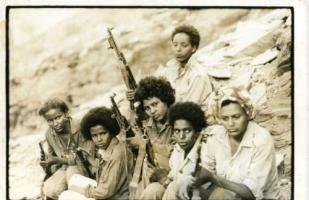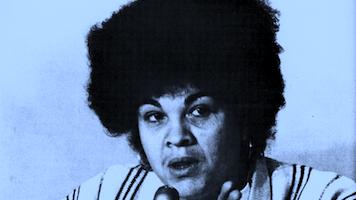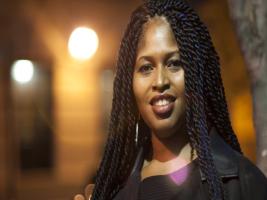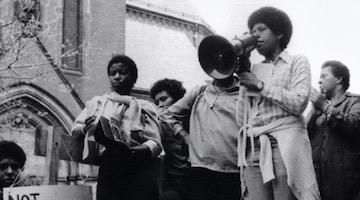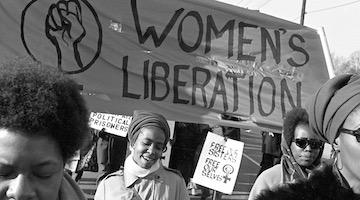Intersection theory insists on the simultaneity of condition, the both/and of Black women’s oppression.
“The wisdom and insight that emerge from collective, mass-based inquiry cannot be attributed to the brilliance of a few individuals.”
The idea that race, class and gender are interrelated dynamics of power and oppression has gained sufficient currency in the academic world to go by the shorthand “intersectionality,” or “intersection theory.” But the origins of contemporary Black feminist theory are not sufficiently known or acknowledged, and, given the invaluable work of university-based theorists, too many assume that the core concepts of Black feminism were born in the academy. In fact, much can be traced to activists in groups including the Student Non-Violent Coordinating Committee (SNCC), the Third World Women’s Alliance, and the Combahee River Collective.
The analytical and methodological insights of Black feminist theory have contributed profoundly to current thinking about women’s condition. Intersection theory insists on the simultaneity of condition, the both/and of Black women’s oppression. Numerous Black feminist theorists have advanced the view that Black women’s experience as women is indivisible from their experiences as African Americans. They are always “both/and,” so analyses that claim to examine gender while neglecting a critical stance toward race and class inevitably do so at the expense of African American women’s experiences.
Black feminist theory also explores the issue of how race, class and gender are analytically related to produce an integrated analysis of power and oppression. The dynamism of the relationships among race, class and gender arises from the fact that, while each has its own unique social logic, polarizes different social forces, and generates distinct, characteristic institutional and cultural modalities, each is also, simultaneously, a constituent and formative factor in the development of the others. Black feminist theorists express the inter-relationships among these forms of social inequity in a variety of ways, generating complex geometries and geographies as they try to capture in metaphor the shape, substance and dynamic of Black women’s lives. But all have in common an emphasis on where axes of power intersect, how they articulate with and mediate each other, and the specific effects and consequences of their intersection.
Black feminism also asserts the complexity and heterogeneity of Black women’s experiences, in sharp contrast to the radical erasure of difference that is inherent in the objectification of African American women as the “other.” Encompassed within this assertion of heterogeneity is both the lifting up of the individuality that is too often submerged in stereotype and, at least as important, the recognition of socially and analytically significant differences among African American women – differentiations based, for example, on class, color, sexual orientation, national origin, marital status, region, and age. African American women share a categorical unity within which there is significant diversity of condition, status, and experience.
Finally, Black feminists have been especially attuned to the ways in which stereotyping and cultural iconography vary for women based on their race or ethnicity, and the power of such iconography to intensify the both/and experience of subordination.
The Wellspring of Black Feminist Theory
But where did these insights originate? What is the wellspring of Black feminist theory? It is important to provide a corrective to the misperception that intersection theory has its genesis in the academy, or, worse still, that it can be attributed to a single discipline, sub-discipline or individual.
At least two key strands of Black feminist theory can be traced to activists. In the rich political ferment of the late 1960s and early 1970s, Black women whose activism in the civil rights and Black Power movements had centered on the issue of racial injustice began to discuss their life experiences as women.
In SNCC women activists formed a Black Women’s Liberation Committee and drew up a list of grievances, most of them related to the minimizing of their talents, skills and contributions by the men with whom they worked and struggled. The significance of their start in SNCC is that these were women who had developed a sense of their own power to create change in the course of the civil rights movement. And they were women who had helped develop the ideas about racism central to that movement, most relevantly, that racism is not about individual aberrational behavior, but a matter of deeply structured institutional arrangements that must be fought through collective political action.
In the course of their civil rights/Black Power activism they had learned the all-important lessons of how to mobilize people, how to run a meeting, how to engage in collective processes of reflection and decision-making, and how to draft “who we are and what we want” statements. In other words, SNCC served as an organizational container within which Black women not only matured politically vis a vis the issue of race, but also a site wherein women came to identify sexism as a major factor in their lives.
Resistance to ‘Women’s Issues’
The idea that SNCC should adopt a supportive, positive stance toward “women’s liberation” was fiercely embattled, meeting with resistance typical of the time.
Addressing “women’s issues” was regarded as divisive to the unity required to meet racism head on, and women who insisted on raising sexism as a legitimate political and practical problem were denounced as saboteurs of the Black struggle. In this setting it required great courage to persist. It also required an autonomous setting in which Black women could develop their ideas, their politics and their methods of struggle.
The Black Women’s Liberation Committee of SNCC eventually became the independent Black Women’s Alliance. One of the founders of the Black Women’s Liberation Committee, and a key architect of its transition to the Black Women’s Alliance, was Frances M. Beal. Beal was also the author of an early Black feminist text, “Double Jeopardy: To Be Black and Female.” (Beal 1970) As the title indicates, “Double Jeopardy’s” bottom-line assertion was that Black women’s femaleness was not divisible from their blackness. Thus, the idea of “both/and,” later to be fully elaborated in the academy, first emerged in the context of a highly charged struggle to establish the legitimacy of the Black female voice speaking on her own behalf.
Beal also insisted that it was not the identification of sexism as a substantial problem within the Black community that was divisive and counter-productive, but rather the suppression of Black women’s initiative, especially their initiative in the political arena. And, just as the radical activists of the time had begun to link the development of racism to class relations in capitalist society, so too did Beal relate the subordination of Black women to the dynamics of class. Influenced by the struggles against colonialism and neo-colonialism in what was then called the Third World, the critique of capitalism became central to the organization’s outlook as it transitioned to the Third World Women’s Alliance (TWWA) and expanded its membership to include Latinas and Asian American women.
Triple Jeopardy
When the organization began to publish its newspaper (1971-1975), it did not take long to settle on a name: Triple Jeopardy. The idea that Black women were subordinated on the basis of both their race and gender was extended to encompass the idea that women of color also faced exploitative conditions in the labor force and other forms of subordination specific to working-class women. Just as the conceptual basis for the both/and of race and gender emerged in opposition to the suppression of Black women’s insistence on naming sexism as central to their experience, so too did these early articulations of the race/class/gender triad arise as a fundamentally political assertion. In this case it was a central element in TWWA’s effort to establish its relationship to and distinction from the “white, middle-class women’s movement.” TWWA set its agenda and developed its educational programs in relation to the issues that poor and working class women faced, arguing that middle-class women were neither equipped nor inclined to fight for the rights of those at the bottom.(7) Highlighting the gender, race and class dimensions of the heightened vulnerabilities of Black women and Latinas to sterilization abuse and high rates of infant mortality, for example, TWWA led concerted campaigns to impact policy on these issues.
Interlocking Oppressions
TWWA was certainly not the only site for the development of the theory that race, class and gender intersect to powerfully shape the experiences of women of color. Throughout the country, in consciousness raising groups and political collectives, women of color struggled to understand their reality – and to change it.
An especially cogent articulation of the concept “simultaneity of oppressions” appeared in the 1977 political manifesto of the Combahee River Collective, a Boston-based group of Black feminists with its own rich history of persistent advocacy of embattled, unpopular ideas – including the ideas that lesbians have a central role to play in the development of feminist theory and practice, and that heterosexism is a significant form of social oppression: “The most general statement of our politics at the present time would be that we are actively committed to struggling against racial, sexual, heterosexual, and class oppression and see as our particular task the development of integrated analysis and practice based upon the fact that the major systems of oppression are interlocking.” (Smith et al. 1977, p. 232)
Written by collective members Barbara Smith, Beverly Smith and Demita Frazier, the statement traced the development of the group’s thinking from a focus on racism and sexism to an analysis that included heterosexism and economic exploitation. Like TWWA, they chose to focus their practice on “those struggles in which race, sex, and class are simultaneous factors of oppression.” (Smith, et al. 1977, p. 239)
I have drawn out these bits of history not just to give credit where it is due – though that is important. The larger issue, however, is the recognition of the struggle for social transformation as a powerful generator of theoretical insight. As people engage in developing strategies to influence and shift power relations, they also – if the political movement is broad and vibrant enough – progressively deepen their processes of reflection, reaching more profound and comprehensive understandings of the social dynamics and institutions that shape their lives. The wisdom and insight that emerge from such collective, mass-based inquiry cannot be attributed to the brilliance of a few individuals, although key individuals may play critical roles in sharpening, synthesizing, articulating or documenting the emergence of new concepts out of political struggle. No advanced degrees were required to participate in the discussions out of which emerged the concepts of the both/and of Black women’s reality, the simultaneity of their oppression, and the intersection of race, class and gender. It was, rather, the theoretical production of thoughtful, committed, courageous, and highly engaged women, some of whom went on to elaborate their views in the context of the academy, the vast majority of whom did not. Let us not forget their immeasurable contribution to our current thinking about women’s condition and the dynamics of social oppression.
References with Notes
Anderson-Bricker, Kristin. 1999. “’Triple Jeopardy’: Black Women and the Growth of Feminist Consciousness in SNCC, 1964-1975.” In Kimberly Springer, ed. Still Lifting, Still Climbing: African American Women’s Contemporary Activism. New York: New York University Press.
Beal, Frances M. Interview with author, December 10, 2000.
Beal, Frances M. 1970. “Double Jeopardy: To Be Black and Female.” In Beverly Guy-Sheftall, ed. 1995. Words of Fire: An Anthology of African-American Feminist Thought. New York: The New Press. [Beal emphasizes the influence of Marxism on TWWA’s thinking about Black women’s class position. TWWA’s feminism was also forged in opposition to the proudly patriarchal outlook of many Black nationalist organizations that looked to idealized (or fictionalized) ancient African civilizations for models of gender relations.]
Brewer, Rose M. 1993. “Theorizing Race, Class and Gender: The New Scholarship of Black Feminist Intellectuals and Black Women’s Labor.” In Stanlie M. James and Abena P.A. Busia (eds.), Theorizing Black Feminisms. New York: Routledge. [Brewer calls simultaneity of oppression the “conceptual underpinning of much of recent Black feminist reconceptualization of African-American life. (p. 16)].
Collins, Patricia Hill. 1990. Black Feminist Thought. New York: Routledge. [Collins argues for a “both/and conceptual stance in which all groups possess varying amounts of penalty and privilege…” (1990, p. 225).]
Crenshaw, Kimberlé. 2000. “The Intersectionality of Race and Gender Discrimination.” African American Policy Forum. [Most recently, for example, Kimberlé Crenshaw has defined intersectionality as “a conceptualization of the problem that attempts to capture both the structural and dynamic consequences of the interaction between two or more axes of subordination.” (2000, p. 7) Crenshaw elaborates the intersection metaphor by way of reference to the “traffic” that flows along “the thoroughfares which structure the social, economic or political terrain,” and identifies racialized women’s location at dangerous intersections.]
Harris, Angela. 1990. “Race and Essentialism in Feminist Legal Theory.” Stanford Law Review 42 (February). [Angela Harris calls “the recognition of a self that is multiplicitous” one of the three main contributions of black feminism. (p. 608)].
hooks, bell. 1990. Yearning: Race, Gender and Cultural Politics, Boston: South End Press.
King, Deborah. 1988. “Multiple Jeopardy, Multiple Consciousness: The Context of a Black Feminist Ideology.” Signs 14:1, pp. 42-72.
Mullings, Leith. 1994. “Images, Ideology and Women of Color.” In Maxine Baca Zinn and Bonnie Thornton Dill, eds. Women of Color in U.S. Society. Philadelphia: Temple University Press. [Mullings speaks to the social role of images and stereotypes of African-American welfare mothers and the ways in which “these images reinforce racism and thus help to reproduce the conditions from which the stereotypes emerge.” (p. 276)].
Smith, Barbara, Beverly Smith and Demita Frazier. 1977. “Combahee River Collective: A Black Feminist Statement.” In Beverly Guy-Sheftall, ed. 1995. Words of Fire: An Anthology of African-American Feminist Thought. New York: The New Press.
Zinn, Maxine Baca and Bonnie Thornton Dill. 1994. “Difference and Domination.” In Maxine Baca Zinn and Bonnie Thornton Dill, eds. Women of Color in U.S. Society. Philadelphia: Temple University Press.
This is an edited version of an article entitled “The Wellspring of Black Feminist Theory” that first appeared in 2001: 28 Southern University Law Review, 265-270. It was also published as a working paper by the Women of Color Resource Center.
Linda Burnham is a writer, activist, strategist and political educator whose decades of experience focus on anti-racism, social justice feminism, and securing democracy.
This article previously appeared in Organizing Upgrade and Portside.
COMMENTS?
Please join the conversation on Black Agenda Report's Facebook page at http://facebook.com/blackagendareport
Or, you can comment by emailing us at comments@blackagendareport.com

